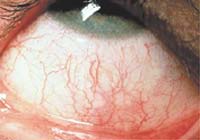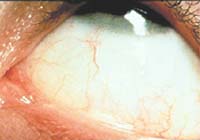Indications for Patanol expanded to include redness
Olopatadine not only treats the itching associated with allergic conjunctivitis, but also other symptoms.
The Food and Drug Administration (FDA) recently approved an expanded indication for Patanol (olopatadine HCl 0.1% ophthalmic solution; Alcon) based on clinical trials conducted by Mark B. Abelson, MD, of the Schepens Eye Research Institute in Boston. The trials demonstrated that olopatadine not only statistically significantly reduces itching associated with allergic conjunctivitis, as previously demonstrated, but that it also statistically significantly reduces redness associated with allergic conjunctivitis. The trials also demonstrated that the solution has an effect on all signs and symptoms of allergic conjunctivitis, including conjunctival chemosis, lid swelling and tearing.
Olopatadine was first approved in 1996 for treatment of itching associated with allergic conjunctivitis. It is one of a class of ocular allergy treatments that combine mast cell stabilization with antihistaminic activity. Gregg J. Berdy, MD, FACS, a clinical instructor at Washington University in St. Louis, said, “This class of combination drugs has all that a physician needs in a treatment. The mast cell stabilizer/antihistamines are exceptionally good. They have a quick onset of action and a long duration of action, are efficacious and are quite comfortable. As a result, these treatments are very well received by patients.”
Clinical trials
 ---Red eye
associated with ocular allergy.
---Red eye
associated with ocular allergy.
Several clinical
trials have demonstrated that olopatadine compares favorably to other topical
ocular allergy drugs. In one trial, olopatadine more effectively targeted mast
cell degranulation than recent mast cell stabilizers (nedocromil, pemirolast)
or the mast cell stabilizer standard cromolyn sodium, and the antihistamine
component increased the efficacy of olopatadine when compared to those mast
cell stabilizers. Another trial conducted by Jean Deschenes, MD, and colleagues
indicated that olopatadine was significantly more effective than the
nonsteroidal anti-inflammatory drug ketorolac in reducing itching and
hyperemia.
Dr. Berdy and colleagues conducted a trial comparing olopatadine to another antihistamine/mast cell stabilizer, ketotifen fumarate. The results showed that olopatadine was more effective than ketotifen in reducing itching associated with allergic conjunctivitis and was more comfortable. “Olopatadine is also very well tolerated, an important consideration in my patient population,” Dr. Berdy said, “and when that tolerance is combined with twice-a-day dosing, it makes life easier for the physician and the patient. Olopatadine also enjoys a low failure rate.”
The clinical trial responsible for the expanded indication was conducted at multiple sites. It was randomized, masked, parallel and used a hybrid environmental study design. The investigators enrolled subjects who had a history of allergic conjunctivitis and a positive reaction to ragweed antigen. A subset of the subjects also had a history of allergic rhinitis. The subjects were given study medication to dose twice daily for the duration of the season. The subjects, half of whom were treated with olopatadine and half with placebo, evaluated their ocular itching, ocular redness, tearing and rhinitis. The study showed that, compared to placebo, olopatadine statistically significantly reduced the effects of the antigen on all signs and symptoms.
“This study design,” Dr. Abelson said, “precisely evaluates the efficacy of topical ocular anti-allergic medications. Older environmental study designs do not adequately account for all variables, so the drug effect is difficult to demonstrate. In contrast, the hybrid environmental model uses several controls, thereby ensuring that the subjects are susceptible to the antigen and, when the antigen is in season, that the subject will manifest the signs and symptoms of seasonal allergic conjunctivitis.”
Results
 ---The same eye
after it was treated with Patanol.
---The same eye
after it was treated with Patanol.
Based on the
results of the study, the FDA expanded the indication for olopatadine from
“temporary prevention of ocular itching due to allergic
conjunctivitis” to “treatment of the signs and symptoms of allergic
conjunctivitis.” M.J. Discepola, MD, an assistant professor of
ophthalmology at McGill University in Montreal, pointed out that this not only
means that olopatadine treats the itching associated with allergic
conjunctivitis, but also redness, chemosis, lid edema and tearing. This
indication makes olopatadine the only drug in its class to have such an
indication.
According to Dr. Abelson, this expanded indication is quite significant. “Consider that approximately one-fifth to one-fourth of the world’s population suffers from some form of allergic disease. ... That olopatadine allows for the complete management of ocular allergic disease eases the burden of practitioner and patient alike,” he said.
For Your Information:
- Jason S. Casavant, JD, can be reached at Ophthalmic Research Associates, Inc., 863 Turnpike St., North Andover, MA 01845; (978) 685-8900; fax: (978) 689-0020; e-mail: jcasavant@oraclinical.com. Mr. Casavant is a medical writer for Ophthalmic Research Associates, Inc. He has no direct financial interest in any of the products mentioned in this article, nor is he a paid consultant for any companies mentioned.
